After riding in a bus for almost three hours through the desert, we arrived at our oasis for lunch.
Seti Abu Simbel Lake Resort had an inviting swimming pool, which on this very hot day tempted some to ask with a wink if they could stay there and have the bus pick them up after the rest of us toured Abu Simbel.
The stylish, modern restaurant gleamed with cleanliness, and this was obviously a great choice, though for all I know it may have been the only choice out in the desert, other than a little windblown, roadside shack with restrooms where we made a brief stop an hour earlier.
The neat, polite waiters served generous portions of hummus and baba ghanoush, along with flat bread to dip in them. I found it all delicious and finished mine with relish.
When the main course arrived, most of us received personal-sized brown olla dishes filled to the brim with beef in a stew-like gravy.
Everyone else seemed to enjoy their meals, but to me the meat tasted tough and gamey. Perhaps the appetizers had ruined my appetite, but I was done after a couple of bites of the beef. Probably just as well, because I had been eating too much heavy food throughout this trip.
Back on the road, we didn't have far to go before we reached Abu Simbel.
From the parking lot, it was a long walk to the Temples for Ramses II and his wife Nefertari. The heat well over 100 degrees Fahrenheit.
As we had seen in pictures, the huge seated Ramses II statures awaited us at the doorway for the Temple of Ramses II.
The entrance hallway was aligned to allow the sun to shine through twice a year to illuminate statues of three gods.
There actually are four statues, but the one on the viewer's left that can be seen inside that inner sanctum remained in the shadows, because he was the god of the underworld.
Like Philae Temple, Abu Simbel was deconstructed and moved to higher ground to protect it for future generations by UNESCO. We watched a video on the bus ride that showed how they accomplished such a remarkable task, including the preservation of the Temple's orientation to preserve what would have been perceived as a miracle at the time of the Pharaohs.
It is a sort of magic. How did ancient engineers possibly orient construction of such a massive structure so perfectly 3,500 years ago, and how could ancient astronomers calculate exactly how this "special effect" might light the "gods" to create the effect? How would workers carry out that plan without modern tools and earthmoving equipment?
Re-creating that effect was a difficult task for advanced engineers with mid-20th Century equipment.
The task of precisely cutting what is essentially a work of art carved into a mountainside required modern skilled craftsmen with muscles of steel and state of the art saws.
In every way conceivable, this was literally a monumental task, and I have to say that was quite a miracle in the 1960s before they had late 20th or early 21st Century state-of-the art computers to do the calculations. I remember slide rules, do you?
What could justify such a massive effort and expenditure? Who does this massive monument honor?
Pharaoh Ramses II was also known as Ramses the Great, and these Temples were meant to convey his greatness to any who approached them.
This temple was built at the far southern extreme of Egypt. The huge statues that implied godlike powers were intended to scare off anyone who would dare approach with ill-intent.
Stepping past them into the doorway, we passed carvings of slaves roped together, warning that anyone who dares to attack Egypt will soon find themselves in bondage, if not dead on the battlefield.
While he had several successors who bore his name through Ramses XI --- we visited the fabulous Tomb of Ramses V and VI in the Valley of the Kings --- they oversaw an Egypt going through a 500 year decline. The early reign of Ramses II is considered a peak of Egyptian power and prestige.
Note that 500 years is twice as long as the United States of America has been a nation, so it wasn't like Egypt suddenly fell off a cliff. Egypt had accumulated a great deal of wealth, so it took a long time for the decline to run its course.
The Pharaohs who followed Ramses II were not so Great, but not total disasters.
Over decades, Egypt splintered into several petty kingdoms which fought among themselves. This weakened the nation, leading to invasion and losing sovereignty to kingdoms of Persia and Assyria, among others, and eventually of course Alexander the Great, the Greek Ptolemies and the Romans.
Ramses II had trials and tribulations in his reign, too, but his large building projects masked any shortcomings.
Early in his reign, Ramses II set the goal of conquering the Hittites (modern day Turkey), but instead marched his formidable military of a very wealthy nation into a trap.
As the battle turned to a rout, he led his brave soldiers to escape, but it was hardly a great victory.
It is as a wonderful win for Egypt, however that it subsequently would be proclaimed in the artwork at various large building projects, including our afternoon destination of Abu Simbel.
According to our guide Fawzy, the Hittites also claimed victory in that war. The Hittites probably had a better claim to the win, in that they had forced Ramses the Great to retreat back to Egypt after defeating Egypt's seemingly overwhelming force in the Battle of Kadesh. At best, it was a draw for Egypt.
Whatever the case, when he returned home from that battle, Ramses II did all that was expected of him as Pharaoh, meaning that he led his army, built impressive architectural projects and played his godlike part in public ceremonies...plus, as Fawzy said, had a lot of sons and daughters with many wives and concubines.
In the Valley of the Kings, we visited his tomb. It probably had more treasure than any other Pharaoh's tomb, by virtue of how long he reigned, but it was all plundered in ancient times.
Ramses the Great became pharaoh as a teenager and ruled for 67 years.
He also built the largest tomb in Egypt to house his 52 sons in the Valley of the Kings, and it is still being excavated. In the Valley of the Queens, Ramses II built what many say is the most beautiful tomb anywhere for his beloved primary wife, Nefertari. We did not visit that monument.
Nefertari was stunningly beautiful. Her name translates as "Beautiful Companion."
She married Ramses II before he became pharaoh.
They were probably both teenagers when they wed, but he adored her for their entire marriage.
It's quite possible she was Nubian.
Ramses II loved her so much that he built a huge temple dedicated to her adjacent to his own at Abu Simbel.
Many of the carvings in her temple also feature Ramses II, but it was nonetheless quite a tribute to his Queen and favorite wife.
According to Professor Robert Brier, Nefertari died unexpectedly when both she and Ramses II were about 40, and it not only broke his heart but really dashed his spirit. In addition, his first born son died, among other children and people who were important to him.
After those losses, Ramses II uncharacteristically signed a peace treaty with the Hittites. Brier said the Hittites were in a war with the Assyrians, so they really needed this treaty to avoid fighting on two fronts, but Ramses did not need it. This may have been the first peace treaty in history, and it was to some extent included mutual defense and also branched into trade, so quite sophisticated.
This original document sent by the Hittites was engraved in silver rather than stone, and stamped with a royal seal. This grandiose gesture impressed Ramses II so much that he mentioned it when he engraved a copy on the walls at Karnak, Abu Simbel and a few other prominent places.
The younger Ramses II would only agree to sign a temporary truce with the Hittites, signaling his intent to seek revenge, so he had definitely mellowed with age. Maybe he became enlightened.
He seemed to be ready to rest on his laurels rather than conquer foreign powers or even give one of his enemies concern about a a possible attack from the rear.
I asked Fawzy about Professor Brier's theory, and he dismissed the theory that Ramses II had faded in power throughout his life, though he acknowledged that Ramses must have loved Nefertari quite a lot to build this colossal monument to her. Of course, becoming a man of peace might have signaled a growth in wisdom for Ramses II, meaning he was powerful in another way.
In any case, he later actually married a couple of Hittite Princesses with large dowries, which he boasted about. When the Hittite king requested Egypt's renowned medical care to help his sister get pregnant, Ramses II sent back a rather humorous reply, which as Brier translates, was something like I know your sister, and she's 50 if she's a day. She's beyond child-bearing, but I'll have one of our doctors help her try.
Fawzy said Ramses II was a very successful Pharaoh, other than than his failed Hittite campaign, and he nonetheless used that to advertise his greatness. End of story.
As someone who loved Sunday School stories from The Bible growing up, when I heard Brier's initial version of a broken heart leading to the dramatic change in Ramses II, I immediately thought about the story of Moses and the Israelites.
Brier came around to the possibility of that theory by the end of the Ramses II classes in Great Pharaohs of Ancient Egypt, but it always feels nice to deduct a conclusion just before it is revealed, like solving a mystery before a TV detective.
Ramses II's first born died at about the right year that The Bible said Moses warned Pharaoh that the first born sons of Egypt would all die if the Pharaoh did not release his people, the Israelites, from slavery.
The Bible doesn't name the Pharaoh specifically, but the Exodus seems to fall in the correct time frame of the 14th Century BCE, or about 3,500 years ago, for Ramses the Great.
Keep in mind that counting backwards is not always an exact science, especially when history is coming from multiple sources with their own calendars in barely literate times.
Based on my rudimentary understanding of The Bible, it seems very likely to me that Pharaoh, upon realizing he was not actually god, would definitely change his way of life upon encountering the real God's power firsthand.
If you haven't read the story or seen a movie about the event, you should look into the Exodus of Israelites led by Moses. The classic movie The Ten Commandments covers the subject. Or you can click on this Encyclopedia Britannica link for a short version of events.
The stories from Exodus are at the heart of the shared values of Western Civilization and embedded in many ways into the English language, so you should learn it, regardless of your personal religious beliefs.
You should at least know that after the Pharaoh's decree to kill all first born children of the Israelites, Moses's mother put him in a little boat and floated him down the Nile, where he was found by an Egyptian princess who took mercy on him.
Interestingly, there are several Pharaoh names that include variations of the name Moses, and it seems to be more likely an Egyptian name than a Hebrew name. There is a similar Hebrew word for Moses that means "to draw out," but why would an Egyptian princess give the baby a Jewish name? In Egyptian, Moses means "birth" or "born," which makes sense too.
Moses was raised in a privileged royal household. When he grew to be an adult, he felt pity for the enslaved Israelites. From my reading, incidentally, the Israelites were not enslaved because they had lost a war, like those on the side walls at the Temple of Ramses II entryway.
Flashback about 400 years when a man named Jacob (the father of Joseph of multi-colored coat fame) and his family of 70 immigrated to Egypt to escape famine in Canaan. Fast forward back to the time Moses was born, and these first Jews prospered to the point where their population swelled to three million.
Pharaoh became leery that they were too independent and might fight on behalf of his enemies --- or at least that was the rationalization --- so he enslaved them all and put them to work building cities, including the capital city of Ramses.
Seeing these people enslaved unfairly, Moses made the case to Pharaoh which fell on deaf ears until a series of plagues were sent by God, with Moses repeatedly saying, "Let my people go!"
After the plague that killed his son, and losing Nefertari around the same time, Pharaoh finally relented. But right after the Israelites were on their way, Pharaoh changed his mind.
A chase across the desert climaxed after the Israelites reached the Sea of Reeds (not actually the Red Sea as often repeated) with Pharaoh's Army hot on their trail. God divided the sea before them to create a path, and they made it safely to the other side. When Pharaoh's Army gave chase, they were swallowed by the water.
And between the birth of Moses and the Exodus across the Sea of Reeds, there's also quite an important part of the story about Moses going to Mt. Sinai and bringing back the Ten Commandments, which formed the foundations for the morality and legal system of Western Civilization.
Of course, Western Civilization has taken some surprising turns of late. In some cities in the United States, for example, monuments to Presidents George Washington, Abraham Lincoln and Teddy Roosevelt have been removed from public settings or vandalized. Their names have been removed from schools.
Getting back to my earlier question, "Who does this massive monument honor?"
I don't need to itemize the offenses of Ramses the Great based on modern sensibilities for it to be obvious that perhaps "cancelling" such a man and destroying his monuments might be more the order of the day, if many had their way.
About sixty years ago, however, humanity united to save Abu Simbel. I repeat: "What could justify such a massive effort and expenditure?" I would guess a lot of folks would say nothing can justify it.
I for one am happy that earlier sensibilities prevailed.
The artwork inside and outside the temples is remarkable, and we spent a lot of time taking it all in.
However, it was also 108 degrees.
Julie and I wandered over to a nearby souvenir shop that was air-conditioned, just to cool off.
The shop had beautiful merchandise, and if we were collectors of such objets d'arte, we probably would have bought something. If you find yourself at Abu Simbel, check it out for yourself.
After going back in the Temples one more time, Julie was ready to head back toward the bus, because most others in our group had already departed, but I lagged behind to take one last look at some rooms I thought I might have missed.
I still had a little extra time to spare when I started the long, hot walk back to find the bus.
Oddly, it seemed like there were more shops in the little marketplace than I remembered. Had I taken a wrong turn? Strangers offered to show me the correct route, which just happened to go past their store, but I pushed on undeterred to the end of the buildings. Success! I saw Fawzy standing by our bus.
Perhaps those locals were really trying to pull me through a shortcut, but I had heard stories about how that could lead to trouble. In any case, it turned out fine, and I boarded the bus for the long ride back to our ship. Always be cautious when you are a stranger in a strange land.
On the bus ride, we had long conversations with fellow passengers to pass the time, including a physician's assistant who made what I thought was an interesting observation about terrible pain, which is something I had dealt with a couple of months earlier.
She said she would ask patients how bad their pain was on a scale of 1 to 10, they often they would say 10, or even 11. She started rephrasing. "If Jesus being tortured on the cross with spikes through him is a 10, how great is your pain?" Some would still say 11. Humans are funny people, aren't we?
Abu Simbel is an incredible destination. If our itinerary had not been changed after we already booked this non-refundable optional excursion, and we had known we would visit Philae Temple that morning, then we might have opted to rest on the ship for the afternoon. Some others who had paid to go nonetheless went back to the ship rather than continuing to Abu Simbel, forfeiting what they paid.
But the incredible site will be part of our memories, so I'm glad we experienced it in person.


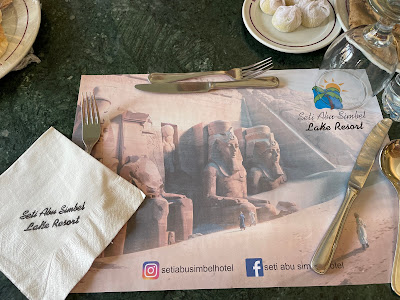


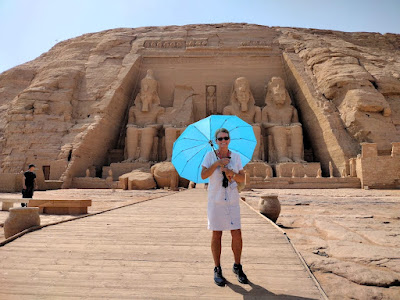






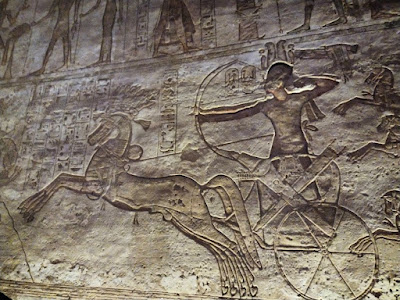

























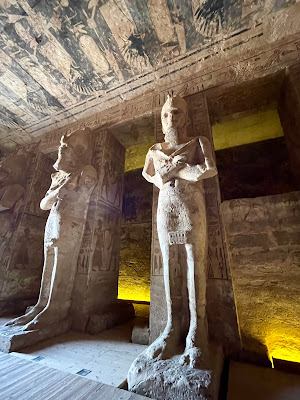

















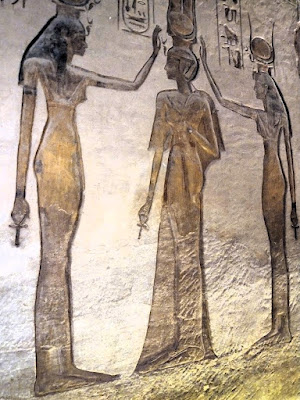
















No comments:
Post a Comment